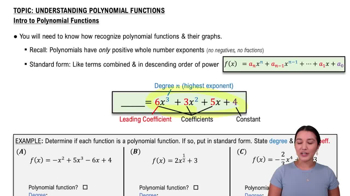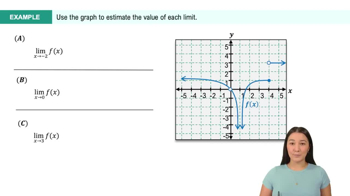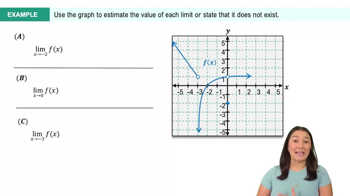Table of contents
- 0. Functions7h 52m
- Introduction to Functions16m
- Piecewise Functions10m
- Properties of Functions9m
- Common Functions1h 8m
- Transformations5m
- Combining Functions27m
- Exponent rules32m
- Exponential Functions28m
- Logarithmic Functions24m
- Properties of Logarithms34m
- Exponential & Logarithmic Equations35m
- Introduction to Trigonometric Functions38m
- Graphs of Trigonometric Functions44m
- Trigonometric Identities47m
- Inverse Trigonometric Functions48m
- 1. Limits and Continuity2h 2m
- 2. Intro to Derivatives1h 33m
- 3. Techniques of Differentiation3h 18m
- 4. Applications of Derivatives2h 38m
- 5. Graphical Applications of Derivatives6h 2m
- 6. Derivatives of Inverse, Exponential, & Logarithmic Functions2h 37m
- 7. Antiderivatives & Indefinite Integrals1h 26m
1. Limits and Continuity
Introduction to Limits
Problem 2.7.41
Textbook Question
Use the precise definition of a limit to prove the following limits. Specify a relationship between ε and δ that guarantees the limit exists.
lim x→1 x^4=1
 Verified step by step guidance
Verified step by step guidance1
Step 1: Recall the precise definition of a limit. For the limit \( \lim_{{x \to 1}} x^4 = 1 \) to hold, for every \( \varepsilon > 0 \), there must exist a \( \delta > 0 \) such that whenever \( 0 < |x - 1| < \delta \), it follows that \( |x^4 - 1| < \varepsilon \).
Step 2: Start by expressing \( |x^4 - 1| \) in a form that can be manipulated. Notice that \( x^4 - 1 = (x^2 - 1)(x^2 + 1) = (x - 1)(x + 1)(x^2 + 1) \).
Step 3: To ensure \( |x^4 - 1| < \varepsilon \), we need to bound \( |(x - 1)(x + 1)(x^2 + 1)| \). Assume \( |x - 1| < 1 \), which implies \( 0 < x < 2 \). This gives us bounds for \( |x + 1| \) and \( |x^2 + 1| \).
Step 4: Calculate the bounds: \( |x + 1| < 3 \) and \( |x^2 + 1| < 5 \) when \( 0 < x < 2 \). Therefore, \( |(x - 1)(x + 1)(x^2 + 1)| < |x - 1| \cdot 3 \cdot 5 = 15|x - 1| \).
Step 5: To satisfy \( |x^4 - 1| < \varepsilon \), choose \( \delta = \frac{\varepsilon}{15} \). This ensures that whenever \( 0 < |x - 1| < \delta \), it follows that \( |x^4 - 1| < \varepsilon \), thus proving the limit.
Recommended similar problem, with video answer:
 Verified Solution
Verified SolutionThis video solution was recommended by our tutors as helpful for the problem above
Video duration:
5mPlay a video:
Was this helpful?
Key Concepts
Here are the essential concepts you must grasp in order to answer the question correctly.
Limit Definition
The precise definition of a limit states that for a function f(x) to approach a limit L as x approaches a value c, for every ε > 0, there exists a δ > 0 such that if 0 < |x - c| < δ, then |f(x) - L| < ε. This formalism is crucial for proving limits rigorously.
Recommended video:

One-Sided Limits
Epsilon-Delta Relationship
In the context of limits, the ε (epsilon) represents how close f(x) must be to the limit L, while δ (delta) represents how close x must be to c. Establishing a relationship between ε and δ is essential to demonstrate that as x gets sufficiently close to c, f(x) will be within ε of L.
Recommended video:

Finding Differentials
Polynomial Functions
Polynomial functions, such as f(x) = x^4, are continuous everywhere on their domain. This property simplifies limit calculations, as the limit of a polynomial as x approaches a point can be found by direct substitution, making it easier to apply the ε-δ definition.
Recommended video:

Introduction to Polynomial Functions

 6:47m
6:47mWatch next
Master Finding Limits Numerically and Graphically with a bite sized video explanation from Callie
Start learning




